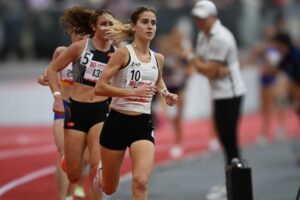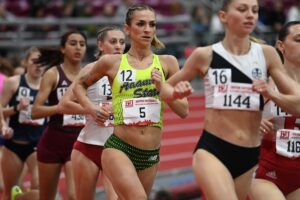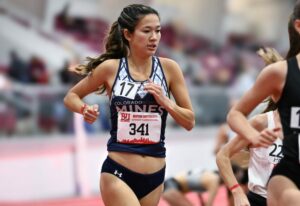Women’s Running published an article last week about why there are so many “fast women” (specifically in the marathon, in the U.S.) right now, and not surprisingly, I have opinions about this.
First I’ll go through their points, then add a few more.
It’s a generational thing. They point out that those who are reaching their prime today grew up after 1984, when Joan Benoit Samuelson won the first Olympic marathon for women. That is true, but it’s been true for a while now. I think in general, the farther we get from the more sexist ways of our past, the more women’s sports are going to thrive.
There’s still a lot of room for growth, and I see this all the time as a parent—boys still dominating sports on the playground, and more sports-themed onesies for boys. There will continue to be room for growth in all sports until women’s sports get as much coverage and fan support as men’s sports.
More successful female role models. I agree with this. There’s no question, for instance, that Shalane Flanagan and Des Linden’s major marathon victories inspired many women of all abilities, and success is contagious.
Big goals and the means to achieve them. The article specifically mentions Boston qualifying and Olympic Trials qualifying standards, but I disagree that that’s led to any sort of change, because those standards have been around for a long time. I do think more people want to achieve them now, partially because more are aware of them (thanks in part to social media), and there’s no question that the Boston Marathon’s popularity increased after the events of 2013.
Social media. This is true across the board, at all levels of running. It’s allowed for more information sharing about training, gear, fuel, coaches, etc. It also allows a firsthand look at what it takes to be great. You see more recreational runners than ever adopting the habits of the pros—Normatec boots, Maurten, Vaporflys, cryotherapy—it’s a dream-come-true for the people trying to sell these products. But also, when you see that someone else is getting up at 4:30 a.m. or running 100 miles per week to make their dream happen, you see that it’s possible.
Teamwork. This is true at all levels, and social media has helped connect women with similar training goals. At the professional level, there are more teams for women than ever before (but there’s room for growth there too—some top teams currently have small women’s rosters or no women).
On top of that, the pros have learned to work together. With the revival of training groups around 2000, the early word was that some coaches were finding that pro women could only train together if they competed in different events or were from different countries, which has since been proven untrue many times over.
If you haven’t read Lindsay Crouse’s 2017 article about the “Shalane Flanagan Effect,” it’s a great outline of how this has worked. Flanagan was not the first female runner to figure this out, but she was one of the more prominent ones to do so, and the ripple effect has been huge.
Now here’s what I would add:
Technology. I don’t think the role of technology can be discounted. I’d love to see what Joan Benoit Samuelson (who ran 2:21:21) could have run in the marathon in her peak wearing Nike Vaporflys, fueling with Maurten, sleeping in an altitude tent, and coming back from injury with the help of an Alter-G or underwater treadmill. Heck, even modern fabrics might have helped her.
We also know more about how to train than ever before. Altitude isn’t exactly technology, but with the rise of groups and funding for those groups, more pro women are spending at least part of their year training at altitude.
A crackdown on doping. At the highest levels, drug use has been rampant in women’s running since before women were running long distance at the Olympic Games. With the drug bust of Rita Jeptoo in 2014 came more awareness of the fact that drug testing was inadequate or nonexistent in some countries.
Next came the discovery of systemic doping in Russia, which has disproportionately affected women’s running. And then came the news that not only were athletes doping, but our sport’s governing body was aware of it and accepting bribes from athletes to keep it under wraps. So the U.S.’s best athletes are currently having more success at the highest levels partially because the sport has been cleaned up somewhat (though there’s still work to do, and Americans cheat sometimes too).
Improved nutrition, healthier runners. One of Flanagan’s (and Elise Kopecky’s) biggest contributions to running is their cookbooks. I remember eating dinner with a handful of the fastest women in the U.S. after they competed in an event in the early 2000s. I was disappointed that all of them ordered very light meals, as if they were afraid to eat too much, or at least afraid to have their competition see them doing so.
But since then, the focus has shifted from low-fat/low-calorie to fueling one’s body well. With her cookbooks, Flanagan has provided a detailed guide on how to do this, and the word has spread that a well nourished runner is a healthier and faster runner.
The talent has always been there, now the opportunities are growing. As legendary coach Arthur Lydiard said long ago, “Champions are everywhere.” The more I coach, the more I see this at all ages. So many women who think they are slow or average runners have just never really learned to train properly, or have never done enough of it to get a sense of their potential.
There have been many U.S. women with a lot of running talent for a long time now, but now, more than ever, that talent is mixing with desire, opportunity, time, support, and direction, and the results are inspiring.






[…] Why so many fast women? […]